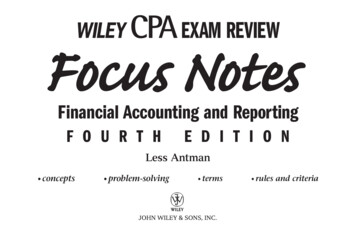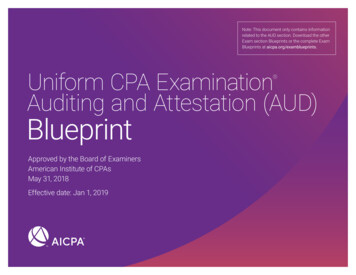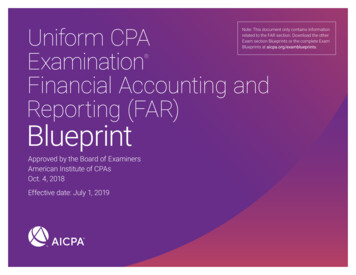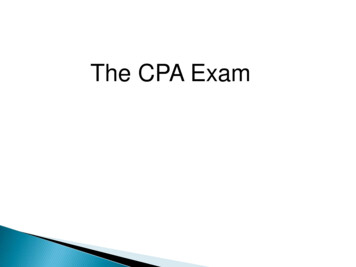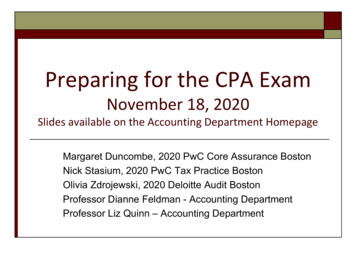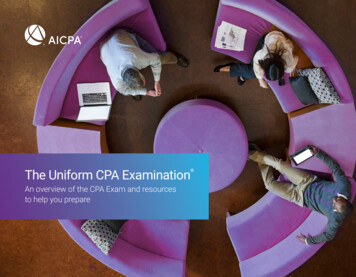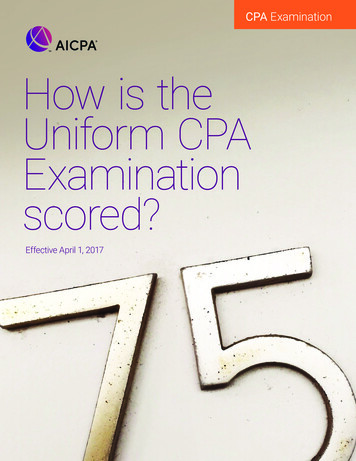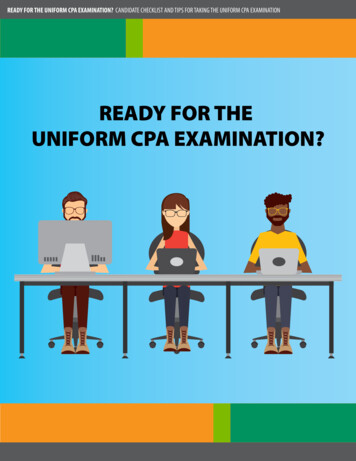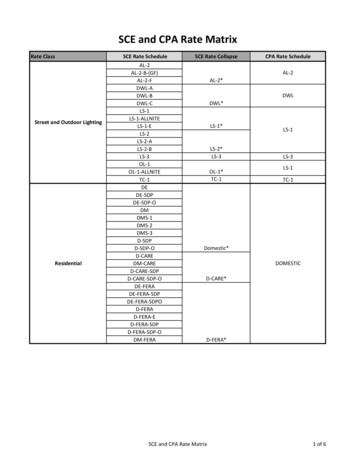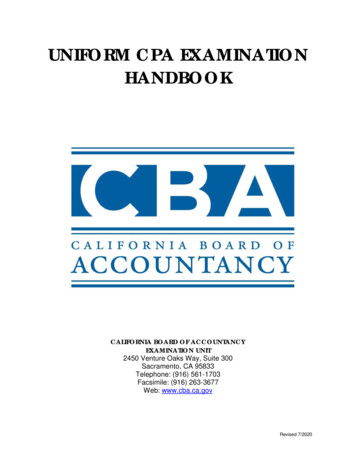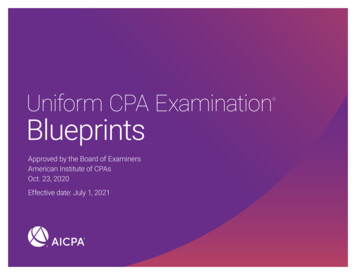
Transcription
Uniform CPA Examination BlueprintsApproved by the Board of ExaminersAmerican Institute of CPAsOct. 23, 2020Effective date: July 1, 2021Uniform CPA Examination Blueprintsi
Uniform CPA Examination BlueprintsTable of contents2AUD1Introduction: Uniform CPA Examination BlueprintsFAR1Auditing and Attestation (AUD)AUD2Section introductionAUD6Summary blueprintFinancial Accounting and Reporting (FAR)FAR2Section introductionFAR6Summary blueprintFAR7Area I — Conceptual Framework, Standard-Settingand Financial ReportingAUD7Area I — Ethics, Professional Responsibilitiesand General PrinciplesFAR13Area II — Select Financial Statement AccountsFAR19Area III — Select TransactionsAUD11Area II — Assessing Risk and Developinga Planned ResponseFAR24Area IV — State and Local GovernmentsAUD17Area III — Performing Further Proceduresand Obtaining EvidenceAUD22BEC1Area IV — Forming Conclusions and ReportingBusiness Environment and Concepts (BEC)REG1Regulation (REG)REG2Section introductionREG5Summary blueprintREG6Area I — Ethics, Professional Responsibilitiesand Federal Tax ProceduresBEC2Section introductionREG8Area II — Business LawBEC6Summary blueprintREG11Area III — Federal Taxation of Property TransactionsArea I — Enterprise Risk Management, Internal Controlsand Business ProcessesREG14Area IV — Federal Taxation of IndividualsREG16Area V — Federal Taxation of EntitiesBEC7BEC10Area II — EconomicsBEC12Area III — Financial ManagementBEC14Area IV — Information TechnologyBEC17Area V — Operations ManagementUniform CPA Examination Blueprints1
IntroductionUniform CPA Examination BlueprintsThe Uniform CPA Examination (the Exam) is comprised of four sections, eachfour hours long: Auditing and Attestation (AUD), Business Environment andConcepts (BEC), Financial Accounting and Reporting (FAR) and Regulation (REG).The AICPA has adopted a skill framework for the Exam based on the revisedBloom’s Taxonomy of Educational Objectives. Bloom’s Taxonomy classifies acontinuum of skills that students can be expected to learn and demonstrate.The table below presents the design of the Exam by section, section time andquestion type.Approximately 570 representative tasks that are critical to a newly licensedCPA’s role in protecting the public interest have been identified. Therepresentative tasks combine both the applicable content knowledge and skillsrequired in the context of the work of a newly licensed CPA. Based on the natureof a task, one of four skill levels, derived from the revised Bloom’s Taxonomy,was assigned to each of the tasks, as dquestions (MCQs) simulations (TBSs)WrittencommunicationAUD4 hours728—BEC4 hours6243FAR4 hours668—REG4 hours768—The table below presents the scoring weight of multiple-choice questions(MCQs), task-based simulations (TBSs) and written communication for eachExam section.Skill levelsEvaluationThe examination or assessment of problems, anduse of judgment to draw conclusions.AnalysisThe examination and study of the interrelationshipsof separate areas in order to identify causes and findevidence to support inferences.ApplicationThe use or demonstration of knowledge, conceptsor techniques.Remembering andUnderstandingThe perception and comprehension of thesignificance of an area utilizing knowledge gained.Score weightingSectionMultiple-choicequestions (MCQs)Task-basedsimulations FAR50%50%—REG50%50%—Uniform CPA Examination Blueprints2
IntroductionUniform CPA Examination Blueprints (continued)The skill levels to be assessed on each section of the Exam are included in thetable below.SectionRemembering %35–45%25–35%—*Includes written communicationThe purpose of the blueprint is to: Document the minimum level of knowledge and skills necessary for initiallicensure. Assist candidates in preparing for the Exam by outlining the knowledge andskills that may be tested. Apprise educators about the knowledge and skills candidates will need tofunction as newly licensed CPAs. Guide the development of Exam questions.The tasks in the blueprints are representative and are not intended to be (norshould they be viewed as) an all-inclusive list of tasks that may be tested onthe Exam. It also should be noted that the number of tasks associated with aparticular content group or topic is not indicative of the extent such contentgroup, topic or related skill level will be assessed on the Exam.Each section of the Exam has a section introduction and a correspondingsection blueprint. The section introduction outlines the scope of the section, the contentorganization and tasks, the content allocation, the overview of content areas,the skill allocation and a listing of the section’s applicable reference literature. The section blueprint outlines the content to be tested, the associated skilllevel to be tested and the representative tasks a newly licensed CPA wouldneed to perform to be considered competent. The blueprints are organized bycontent AREA, content GROUP, and content TOPIC. Each topic includes oneor more representative TASKS that a newly licensed CPA may be expected tocomplete.Revised taxonomy see Anderson, L.W. (Ed.), Krathwohl, D.R. (Ed.), Airasian, P.W., Cruikshank, K.A., Mayer, R.E., Pintrich, P.R., Raths, J., & Wittrock, M.C. (2001). A taxonomy for learning, teaching, and assessing: A revision of Bloom’s Taxonomy ofEducational Objectives (Complete Edition). New York: Longman. For original taxonomy see Bloom, B.S. (Ed.), Engelhart, M.D., Furst, E.J., Hill, W.H., & Krathwohl, D.R. (1956). Taxonomy of educational objectives: The classification of educationalgoals. Handbook 1: Cognitive domain. New York: David McKay.Uniform CPA Examination Blueprints3
Uniform CPA ExaminationAuditing and Attestation (AUD)BlueprintUniform CPA Examination Blueprints: Auditing and Attestation (AUD)AUD1
Section introductionAuditing and AttestationThe Auditing and Attestation (AUD) section of the Uniform CPA Examination(the Exam) tests the essential knowledge and skills a newly licensed CPA mustdemonstrate when performing audit engagements, attestation engagements oraccounting and review service engagements.Newly licensed CPAs are required to: demonstrate knowledge and skills related to professional responsibilities,including ethics, independence and professional skepticism. Professionalskepticism reflects an iterative process that includes a questioning mind anda critical assessment of audit evidence. understand the entity including its operations, information systems (includingthe use of third-party systems) and its underlying business processes, risksand related internal controls. understand the flow of transactions and underlying data through a businessprocess and its related information systems.Content organization and tasksThe AUD section blueprint is organized by content AREA, content GROUP andcontent TOPIC. Each topic includes one or more representative TASKS that a newlylicensed CPA may be expected to complete when performing audit engagements,attestation engagements or accounting and review service engagements.The engagements tested under the AUD section of the Exam are performed inaccordance with professional standards and/or regulations promulgated by variousgoverning bodies A listing of standards promulgated by these bodies, and otherreference materials that are eligible for assessment in the AUD section of the Examare included under References at the conclusion of this introduction.control integrated with an audit of financial statements and audits of entitiesreceiving federal grants. Audits may be for issuer entities subject to the auditrequirements set forth by the Public Company Accounting Oversight Board(PCAOB), nonissuer entities subject to the audit requirements set forth by theAmerican Institute of CPA’s (AICPA) Auditing Standards Board or governmentalentities subject to the audit requirements of the U.S. Government AccountabilityOffice or the Office of Management and Budget. Attestation engagements - Examinations, reviews or agreed-upon proceduresengagements that a newly licensed CPA may perform in accordance with therequirements set forth by the AICPA’s Auditing Standards Board. Accounting and review service engagements - Preparation, compilation andreview engagements that a newly licensed CPA may perform in accordancewith requirements set forth by the AICPA’s Accounting and Review ServicesCommittee.For example, tasks related to Analytical procedures (included under Area III, GroupC, Topic 1) may be performed during a review engagement as a presumptivelymandatory procedure, or during an audit engagement as a substantive procedure,or near the end of the engagement to assist with forming an overall conclusion onthe financial statements.The tasks in the blueprint are representative. They are not intended to be (norshould they be viewed as) an all-inclusive list of tasks that may be tested in theAUD section of the Exam. Additionally, it should be noted that the number of tasksassociated with a particular content group or topic is not indicative of the extentsuch content group, topic or related skill level will be assessed on the Exam.Similarly, examples provided within the task statements should not be viewed asall-inclusive.Candidates should be aware that the tasks included in the AUD blueprint may, andtypically do, relate to and can be applied to various engagement typessuch as: Audit engagements - Financial statement audits as well as other types of auditsa newly licensed CPA may perform, such as compliance audits, audits of internalUniform CPA Examination Blueprints: Auditing and Attestation (AUD)AUD2
Section introductionAuditing and Attestation (continued)Content allocationThe following table summarizes the content areas and the allocation of contenttested in the AUD section of the Exam:Content areaAllocationArea IEthics, Professional Responsibilitiesand General Principles15–25%Area IIAssessing Risk and Developing a PlannedResponse25–35%Area IIIPerforming Further Procedures andObtaining Evidence30–40%Area IVForming Conclusions and Reporting10–20%Overview of content areasArea I of the AUD section blueprint covers several topics, including ethics,independence and professional conduct and concepts relating to professionalskepticism and professional judgment. This area also includes the nature andscope of an engagement, engagement terms, documentation, communicationrequirements and quality control.The remaining three areas of the AUD section blueprint (Areas II, III and IV)cover the activities that a newly licensed CPA should be able to perform whenproviding professional services related to audit, attestation and accountingand review service engagements. The organization of these sections follows atypical engagement process, from planning through reporting.Area II of the AUD section blueprint covers planning, risk assessment anddesign of procedures responsive to identified risks. The area is focused onobtaining an understanding of an entity, its environment (internal and external),business processes, information systems and internal controls (manual andautomated) in order to appropriately assess the risk of material misstatementdue to fraud or errors and to design appropriate procedures to respond to thoseidentified risks.Uniform CPA Examination Blueprints: Auditing and Attestation (AUD)Area III of the AUD section blueprint covers performing planned engagementprocedures that are responsive to identified risk. The area is focused onconcluding on the sufficiency and appropriateness of evidence obtained byperforming general procedures (e.g. observation, reperformance, sampling,etc.) and specific procedures (e.g. analytical procedures, external confirmationand audit data analytics). This area also covers testing the operatingeffectiveness of internal controls, responding to specific matters that requirespecial consideration (e.g. accounting estimates, inventory, etc.), evaluating andresponding to misstatements and internal control deficiencies.Area IV of the AUD section blueprint covers the reporting requirements foraudit, attestation and accounting and review service engagements. This areaalso includes other reporting considerations such as comparative financialstatements, consistency, supplementary information and special considerationswhen performing engagements under Government Auditing Standards.Section assumptionsWhen completing multiple-choice questions, task-based simulations andresearch prompts in the AUD section of the Exam, candidates should be awareof the entity type and engagement type presented in the question. To the extentthat there are different requirements for an entity under audit or review, thequestion will include an explicit reference to the entity type (issuer or nonissuer).Questions may refer to an audit engagement by including phrases such as“an audit of a nonissuer” or “an audit of an issuer”. Questions will refer to othertypes of engagements by including phrases such as “examination of pro formafinancial information”, “review engagement”, “interim review”, “compilationengagement”, etc. The use of the terms “auditor”, “accountant” or “practitioner”will also be used to further identify engagement types and applicableprofessional standards. Candidates should be mindful of the engagement typewhen answering a question.AUD3
Section introductionAuditing and Attestation (continued)Skill allocationThe Exam focuses on testing higher order skills. Based on the nature of the task,each representative task in the AUD section blueprint is assigned a skill level.AUD section considerations related to the skill levels are discussed below.Skill levelsEvaluationThe examination or assessment of problems, anduse of judgment to draw conclusions.AnalysisThe examination and study of the interrelationshipsof separate areas in order to identify causes and findevidence to support inferences.ApplicationThe use or demonstration of knowledge, conceptsor techniques.Remembering andUnderstandingThe perception and comprehension of thesignificance of an area utilizing knowledge gained. Analysis and Evaluation skills, tested in Area II and Area III, involve tasks thatrequire a higher level of analysis and interpretation. These tasks, such asconcluding on sufficiency and appropriateness of evidence, frequently requirenewly licensed CPAs to apply professional skepticism and judgment. he representative tasks combine both the applicable content knowledge andTthe skills required in the context of the work that a newly licensed CPA wouldreasonably be expected to perform. Remembering and Understanding is mainly concentrated in Area I and Area IV.These areas contain much of the general audit knowledge that is required fornewly licensed CPAs. In Area IV, many of the tasks relate to reporting and aredriven by templates and illustrative examples. Application is tested in all four areas of the AUD section. Applicationtasks focus on general topics such as professional responsibilities anddocumentation, and the day-to-day tasks that newly licensed CPAs perform,frequently using standardized application tools such as audit programs andsampling techniques.Uniform CPA Examination Blueprints: Auditing and Attestation (AUD)AUD4
Section introductionAuditing and Attestation (continued)References — Auditing and Attestation AICPA Statements on Auditing Standards and Interpretations AICPA Audit and Accounting Guides Public Company Accounting Oversight Board (PCAOB) Standards (SEC-Approved)and Related Rules, PCAOB Staff Questions and Answers and PCAOB Staff AuditPractice Alerts AICPA Code of Professional Conduct Sarbanes-Oxley Act of 2002 U.S. Government Accountability Office Government Auditing Standards U.S. Department of Labor (DOL) Guidelines and Interpretive Bulletins re: AuditorIndependence Single Audit Act, as amended SEC Independence Rules Office of Management and Budget (OMB) Audit requirements for FederalAwards (2 CFR 200) Employee Retirement Income Security Act of 1974 AICPA Statements on Quality Control Standards The Committee of Sponsoring Organizations of the Treadway Commission(COSO): Internal Control — Integrated Framework AICPA Statements on Standards for Accounting and Review Services andInterpretations Current textbooks on auditing, attestation services, ethics and independence AICPA Statements on Standards for Attestation Engagements and InterpretationsUniform CPA Examination Blueprints: Auditing and Attestation (AUD)AUD5
Auditing and Attestation (AUD)Summary blueprintContent area allocationWeightI. Ethics, Professional Responsibilities and General Principles15–25%II. Assessing Risk and Developing a Planned Response25–35%III. Performing Further Procedures and Obtaining Evidence30–40%IV. Forming Conclusions and Reporting10–20%Skill pplication30–40%Remembering and Understanding25–35%Uniform CPA Examination Blueprints: Auditing and Attestation (AUD)AUD6
Auditing and Attestation (AUD)Area I — Ethics, Professional Responsibilitiesand General Principles (15–25%)SkillContent group/topicRemembering sentative taskA. Nature and scope1. Nature and scope: auditengagementsIdentify the nature, scope and objectives of the different types of audit engagements,including issuer and nonissuer audits.2. Nature and scope:engagements conductedunder GovernmentAccountability OfficeGovernment AuditingStandardsIdentify the nature, scope and objectives of engagements performed in accordancewith Government Accountability Office Government Auditing Standards.3. Nature and scope: otherengagementsIdentify the nature, scope and objectives of attestation engagements and accountingand review service engagements.B. Ethics, independence and professional conduct1. AICPA Code ofProfessionalConductUnderstand the principles, rules and interpretations included in the AICPA Code ofProfessional Conduct.Recognize situations that present threats to compliance with the AICPA Code ofProfessional Conduct, including threats to independence.Apply the principles, rules and interpretations included in the AICPA Code ofProfessional Conduct to given situations.Apply the Conceptual Framework for Members in Public Practice included in the AICPACode of Professional Conduct to situations that could present threats to compliance withthe rules included in the Code.Apply the Conceptual Framework for Members in Business included in the AICPACode of Professional Conduct to situations that could present threats to compliancewith the rules included in the Code.Apply the Conceptual Framework for Independence included in the AICPA Codeof Professional Conduct to situations that could present threats to compliance withthe rules included in the Code.Uniform CPA Examination Blueprints: Auditing and Attestation (AUD)AUD7
Auditing and Attestation (AUD)Area I — Ethics, Professional Responsibilitiesand General Principles (15–25%) (continued)SkillContent group/topicRemembering sentative taskB. Ethics, independence and professional conduct (continued)2. Requirements of theSecurities andthe Exchange Commissionand the Public CompanyAccounting Oversight BoardUnderstand the ethical requirements of the Securities and Exchange Commissionand the Public Company Accounting Oversight Board.Recognize situations that present threats to compliance with the ethical requirementsof the Securities and Exchange Commission and the Public Company AccountingOversight Board.Apply the ethical requirements and independence rules of the Securities andExchange Commission and the Public Company Accounting Oversight Board tosituations that could present threats to compliance during an audit of an issuer.3. Requirements of theGovernmentAccountability Officeand the Departmentof LaborRecognize situations that present threats to compliance with the ethicalrequirements of the Government Accountability Office Government AuditingStandards.Recognize situations that present threats to compliance with the ethicalrequirements of the Department of Labor.Apply the ethical requirements and independence rules of the GovernmentAccountability Office Government Auditing Standards to situations that couldpresent threats to compliance during an audit of, or attestation engagement for, agovernment entity or an entity receiving federal awards.Apply the independence rules of the Department of Labor to situations that couldpresent threats to compliance during an audit of employee benefit plans.4. Professional skepticismand professional judgmentUnderstand the concepts of professional skepticism and professional judgment.Understand personal bias and other impediments to acting with professionalskepticism, such as threats, incentives and judgment-making shortcuts.Uniform CPA Examination Blueprints: Auditing and Attestation (AUD)AUD8
Auditing and Attestation (AUD)Area I — Ethics, Professional Responsibilitiesand General Principles (15–25%) (continued)SkillContent group/topicRemembering sentative taskC. Terms of engagement1. Preconditions for anengagementIdentify the preconditions needed for accepting or continuing an engagement.2. Terms of engagementand engagement letterIdentify the factors affecting the acceptance or continuance of an engagement.Identify the factors to consider when management requests a change in the type ofengagement (e.g., from an audit to a review).Perform procedures to confirm that a common understanding of the terms of anengagement exist with management and those charged with governance.Document the terms of an engagement in a written engagement letter or othersuitable form of written agreement.D. Requirements for engagement documentationIdentify the elements that comprise sufficient appropriate documentation for anengagement.Identify the requirements for the assembly and retention of documentation for anengagement.Prepare documentation that is sufficient to enable an experienced auditor having noprevious connection with an engagement to understand the nature, timing, extentand results of procedures performed and the significant findings and conclusionsreached.Uniform CPA Examination Blueprints: Auditing and Attestation (AUD)AUD9
Auditing and Attestation (AUD)Area I — Ethics, Professional Responsibilitiesand General Principles (15–25%) (continued)SkillContent group/topicRemembering sentative taskE. Communication with management and those charged with governance1. Planned scopeand timing of anengagementIdentify the matters related to the planned scope and timing of an engagement thatshould be communicated to management and those charged with governance.Prepare presentation materials and supporting schedules for use in communicatingthe planned scope and timing of an engagement to management and those chargedwith governance.2. Internal controlrelated mattersIdentify the matters related to deficiencies and material weaknesses in internalcontrol that should be communicated to those charged with governance andmanagement for an engagement and the timing of such communications.Prepare written communication materials for use in communicating identifiedinternal control deficiencies and material weaknesses for an engagement to thosecharged with governance and management.F. A firm’s system of quality control, including quality control at the engagement levelRecognize a CPA firm’s responsibilities for its accounting and auditing practice’ssystem of quality control.Apply quality control procedures on an engagement.Uniform CPA Examination Blueprints: Auditing and Attestation (AUD)AUD10
Auditing and Attestation (AUD)Area II — Assessing Risk and Developinga Planned Response (25–35%)SkillContent group/topicRemembering sentative taskA. Planning an engagement1. Developing anoverall engagementstrategyExplain the purpose and significance of the overall engagement strategy for anengagement.2. Developing a detailedengagement planPrepare a detailed engagement plan for an engagement starting with the prior-yearengagement plan or with a template.Prepare supporting planning related materials (e.g., client assistance request listings,time budgets) for a detailed engagement plan starting with the prior-year engagementplan or with a template.B. Understanding an entity and its environment1. External factorsIdentify the relevant external factors. (e.g., industry, regulation, applicable financialreporting framework and technology) that impact an entity and/or the inherent riskof material misstatement, and document the procedures performed to obtain thatunderstanding.2. Internal factorsIdentify the relevant factors that define the nature of an entity, including the impacton the risk of material misstatement (e.g., its operations, ownership and governancestructure, investment and financing plans, selection of accounting policies andobjectives and strategies) and document the procedures performed to obtain thatunderstanding.Obtain an understanding of an entity’s IT systems infrastructure (e.g., ERP, cloudcomputing or hosting arrangements, custom or packaged applications) and documentthe procedures performed to obtain that understanding.Identify and document the significant business processes and data flows that directlyor indirectly impact an entity’s financial statements.Uniform CPA Examination Blueprints: Auditing and Attestation (AUD)AUD11
Auditing and Attestation (AUD)Area II — Assessing Risk and Developinga Planned Response (25–35%) (continued)SkillContent group/topicRemembering sentative taskC. Understanding an entity’s control environment and business processes, including information technology (IT) systems1. Control environment,IT general controls andentity-level controlsIdentify the significant components of an entity’s control environment, including itsIT general controls and entity-level controls, and document the procedures performedto obtain that understanding.2. Business processesand the design of internalcontrols, including ITsystemsPerform a walkthrough of a significant business process and document (e.g., flowcharts, process diagrams, narratives) the flow of relevant transactions and data frominitiation through financial statement reporting and disclosure.Obtain an understanding of IT systems that are, directly or indirectly, the source offinancial transactions or the data used to record financial transactions (e.g. how theentity uses IT systems to capture, store, and process information) and document theprocedures performed to obtain that understanding.Perform tests of the design and implementation of relevant internal controls(application and manual).Identify and document an entity’s relevant IT application controls within the flow ofan entity’s transactions for a significant business process and consider the effect ofthese controls on the completeness, accuracy and reliability of an entity’s data.Identify and document the relevant manual controls within the flow of an entity’stransactions for a significant business process and consider the effect of thesecontrols on the completeness, accuracy and reliability of an entity’s data.Evaluate whether relevant internal controls (application and manual) are effectivelydesigned and placed in operation.Uniform CPA Examination Blueprints: Auditing and Attestation (AUD)AUD12
Auditing and Attestation (AUD)Area II — Assessing Risk and Developinga Planned Response (25–35%) (continued)SkillContent group/topicRemembering sentative taskC. Understanding an entity’s control environment and business processes, including information technology (IT) systems (continued)3. Implications of anentity using aservice organizationUnderstand the differences between SOC 1 and SOC 2 engagements.Identify and document the purpose and significance of an entity’s use of a serviceorganization, including the impact of using a SOC 1 Type 2 report in an audit of anentity’s financial statements.Use a SOC 1 Type 2 report to determine the nature and extent of testing proceduresto be performed in an audit of an entity’s financial statements.4. Limitations ofcontrols and risk ofmanagementoverrideUnderstand the limitations of internal controls and the potential impact on the risk ofmaterial misstatement of an entity’s financial statements.Identify and document the risks associated with management override of internalcontrols and the potential impact on the risk of material misstatement of an entity’sfinancial statements.D. Assessing risks due to fraud, including discussions among the engagement team about the risk of material misstatement due to fraud or errorAssess risks of material misstatement of an entity’s financial statements due to fraudor error (e.g., during a brainstorming session), leveraging the combined knowledgeand understanding of the engagement team.E. Identifying and assessing the risk of material misstatement, whether due to error or fraud, and planning further procedures responsive to identified risks1. Impact of risks atthe financialstatement levelIdentify and document the assessed impact of risks of material misstatement at thefinancial statement level, taking into account the effect of relevant controls.Analyze identified risks to detect those that relate to an entity’s financial statementsas a whole (as contrasted to the relevant assertion level).Uniform CPA Examination Blueprints: Auditing and Attestation (AUD)AUD13
Auditing and Attestation (AUD)Area II — Assessing Risk and Developinga Planned Response (25
Uniform CPA Examination Blueprints: Auditing and Attestation (AUD) AUD2 The Auditing and Attestation (AUD) section of the Uniform CPA Examination (the Exam) tests the essential knowledge and skills a newly licensed CPA must demonstrate when performing audit engagements, attestation
